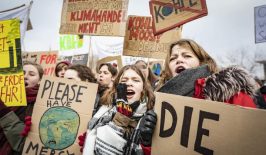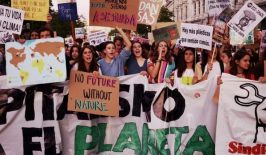When it comes to world climate diplomacy, you can’t get much bigger or more significant than the UN Framework Convention on Climate Change’s Conference of the Parties, also known (a little more snappily) as COP. The conference has taken place in November or December every year since the first one in Rio de Janeiro back in 1992.
A climate conference is a meeting of various parties who come together to try to find solutions for man-made global climate change and global warming. At the meeting, individual states negotiate their reduction commitments and the climate financing necessary to reduce harmful emissions. The overall aim is huge: to stabilise the concentrations of greenhouse gases in the Earth’s atmosphere that are responsible for the global rise in temperature and to try and avert any drastic disturbances in our climate system. Also up for discussion are ideas for climate change adaptation.
Every year, heads of government, organisations and activists from the environment, business and technology meet to negotiate the future of our planet at climate summits and conferences. But what exactly is a climate conference, who is involved and what is the scope of the decisions taken?
Key Stakeholders in World Climate Diplomacy
The work of the UN Climate Change Conferences is mainly supported by two institutions.
1. The Intergovernmental Panel on Climate Change (IPCC) is an intergovernmental scientific committee of the United Nations with headquarters in Geneva, Switzerland. The IPCC evaluates and organises scientific findings, but it doesn’t conduct its own research. Instead, it summarises the results of various studies on the dangers of climate change which contribute to the decisions taken at the conferences.
2. The UNFCCC Secretariat based in Bonn, Germany. Set up in 1992, it is run by an international team of about 500 people. Together with the Presidency, the Secretariat is responsible for the organisation and agenda of the climate summits. It is also responsible for implementing the climate agreements and collecting data on the climate impact of the individual countries.
Who Attends the Climate Conferences?
Over the past two decades, climate conferences have developed into major events with more than 20,000 participants. They include selected government representatives of the 197 signatory states, including all members of the UN as well as the state of Palestine, the island of Niue, the Cook Islands and the European Union. Joining them are journalists and observers from various non-governmental organisations (NGOs). While observers are informed about the decisions being made at the conference and can join in the discussions, they don’t have any decision-making authority. Instead, all decisions are made by the signatory states.
To keep everything organised, NGOs attend the conference in groups. The BINGOs (Business and Industry Non-Governmental Organizations) brings together business lobbyists, including the International Chamber of Commerce (ICC). TUNGOs (Trade Union Non-Governmental Organizations) are representatives of trade unions, meanwhile RINGOs (Research and Independent Organisations) consist of scientific organisations. Naturally, environmental organizations are also involved and call themselves ENGOs (Environmental Non-Governmental Organizations). YOUNGOs, represent the youth movement. When applying for status, access and funds from the Climate Secretariat, they have a pretty convincing argument, namely: “It’s our future that’s being negotiated!”
All of these groups hold side events in order to try to generate attention and thereby also influence the progress of the conference. At these side events, they present the latest findings on different topics: from electromobility to building insulation or coal-fired power plants.
Key Climate Conferences and Their Outcomes
Earth Summit: Rio de Janeiro 1992
In 1992, 130 heads of state and 17,000 other participants met at the first international environmental summit in Rio de Janeiro to discuss global problems such as hunger, poverty, war and the growing social divide between industrialised and developing countries. It was at this conference that climate change was officially recognised as a problem for the first time.
The outcome of the meeting was the United Nations Framework Convention on Climate Change (UNFCCC), which laid the foundation for subsequent climate conferences. The aim was to keep global greenhouse gas concentrations at levels that wouldn’t harm our climate system, and as soon as possible, because climate change seriously threatens natural ecosystems, food security and sustainable economic development.
COP 3: Kyoto 1997
At the third world climate conference in Kyoto, Japan, the climate leaders pushed through the first ever legally-binding climate protection treaty signed by 37 industrialised countries and the European Community: the Kyoto Protocol. This protocol aimed to reduce those countries’ annual greenhouse gas emissions by an average of 5.2 per cent within the first commitment period (2008-2012), when compared to 1990 levels. No reduction targets were laid out for emerging economies and low-income countries. Instead, funds were to be set up to finance climate change adaptation strategies. Under the Protocol, economic incentives for industrialised countries were created via various flexible mechanisms, including the Clean Development Mechanism (CDM). Through CDM, industrialised countries are able to offset emission savings in emerging and developing countries against their own carbon footprint, for example through renewable energies, by participating directly in renewable energy projects or purchasing the relevant certificates.
COP 15: Kopenhagen 2009
Despite being regarded as one of the largest meetings in the history of diplomacy, the 15th Climate Change Conference in Copenhagen in 2009 is also regarded as one of the least successful. Concrete reduction targets were scheduled to be set and signed in Copenhagen but the heads of states were unable to reach any agreement due to a conflict of interests. They also failed to write a legally binding treaty, the expected successor agreement to the Kyoto Protocol. The final outcome of the conference – the Copenhagen Accord – contains the goal of limiting global warming to less than 2 degrees compared to pre-industrial levels. However, the accord was not adopted by the contracting parties and is therefore not legally binding.
COP 16: Cancún 2010
One year later in Cancún 2010, a binding international treaty was finally signed which includes the goal of limiting global warming to a maximum of 2 degrees Celsius. They also discussed the possibility of lowering the 2°C limit to 1.5°C. In order to help out the regions particularly affected by temperature rise, a climate fund was agreed on and set up – the Green Climate Fund (GCF)– as emergency aid with a volume of 10 billion dollars a year. This fund will be used in particular to finance climate protection measures in developing countries. At the same time, a mechanism called REDD+ , “Reducing Emissions from Deforestation and Degradation”, was adopted as a countermeasure to global deforestation. The principle is simple: Whoever protects the forest as a CO2 store should receive a financial incentive for it.
COP 21: Paris 2015
The 21st UNCCC took place in Paris in 2015 and is regarded as a historic event in the world of climate diplomacy. Within the framework of the Paris Agreement, global warming was limited to below two degrees Celsius and, if possible, below 1.5 degrees Celsius, and this was made binding for all participating states. Each country is responsible for their Nationally Determined Contributions. They have to be submitted every five years and contain even more ambitious targets.
What can Climate Conferences Really Achieve?
The COP is preceded by many preparatory meetings, which are planned down to the last detail by the participating government representatives. In addition to the main event, other individual summits are held in parallel. All these events call for a huge logistical effort, as the meetings take place at constantly changing locations. Critics complain that for such huge effort, relatively little is achieved at the climate conferences.
The reasons for the unsatisfactory results can be found in the systematics of world climate diplomacy itself: According to the draft rules of procedure of the climate summits, a decision can only be made when the majority of parties agree. Not all of the participants agree with this. Thus, in the whole history of the climate conference, they have never agreed on what the rules of procedure should be. Instead, conditional UN provisions apply under which all decisions must be taken ‘unanimously’. This means that all signatory states must agree to the Framework Convention on Climate Change. This regulation also means that each individual country can prevent a decision, as happened in Copenhagen in 2009. In part, no binding decision was made because Nicaragua and subsequently Bolivia, Mozambique and Venezuela were against the agreement.
But even if the negotiations seem tough, endless and as if nothing will ever change, we shouldn’t give up hoping for a better world. Even if solutions aren’t always reached, the climate talks have heightened awareness of global issues at the international level. The withdrawal of the USA, the second largest emitter after China, from the Paris Agreement in June 2017, could be viewed as a severe setback. However, their pulling out of the agreement actually raised awareness of the agreement itself, and encouraged others to re-pledge their support for it, maybe even strengthening support for it as a whole. And as was shown a few months later at the COP 23 in Bonn, Trump’s own officials are not necessarily behind his decision. Many US municipalities and states have proclaimed that: “We are still in.”
If you want things to change, you have to actually do something about them yourself. Whether that means calling on policy makers to make the right decisions and enact environmental protection laws (like the EU’s recent ban on single-use plastics), or committing to make small changes in your own day to day life, each and every one of us can take steps to protect our planet. Check out RESET.org’s archive of Act Now articles for inspiration and ideas on how to start.
Latest update: Lena Strauß / RESET Editorial (November 2018)









